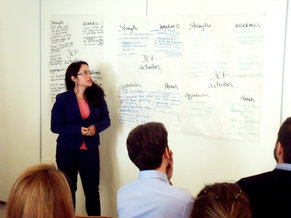|
| |
A competitive advantage is a capability or position that allows you to outperform competitors. This is considered the basis for profitability in a competitive market. In other words, firms that have no advantages can only compete on price. This quickly becomes unprofitable, particularly if the competition have lower costs. Anything that you do better than your competition typically adds to your competitive advantage. Examples include:
Brand image | Brand recognition | Compliance capabilities | Cost efficiency | Customer loyalty | Customer relationships | Customer service quality | Customer support | Customization options | Distribution network | Ecommerce presence | Economies of scale | Efficient processes | Efficient systems | Employee productivity | Employee talents | Existing customer base | Experience | Facilities | Fair terms | Fans & brand advocates | Faster turnaround time | Financial resources | High customer retention | Influencer relationships | Intellectual property | Know-how | Locations | Low customer acquisition cost | Low cost of capital | Market share | Marketing and promotional prowess | Partner relationships | Perceived as good for people & planet | Positive ratings & reviews | Positive word of mouth | Product functions & features | Product quality | Product styles & aesthetics | Product variety | Reputation | Research & development | Risk management capabilities | Service environments such as rooms in a hotel | Service quality | Social media presence | Sourcing advantages | Speed to market | Strategic alliances | Strategy & tactics | Technologies | Trade secrets | Usability of products | User base | Visionary leaders |
ScaleLeveraging economies of scale to drive unit costs down.VarietyOffering a great variety of products and services can lead to efficiencies such as reduced cost. Customers may also value variety such as the selection offered by a large supermarket.Know-howThe skills, abilities and experience of your employees is a critical factor in most industries.ProcessesEfficient operational processes that get things done faster, cheaper or better.Organizational CultureOrganizational culture are the norms, values and habits that are unique to every organization. For example, some companies embrace aggressive innovation while others tend to resist the most conservative of changes.CapitalAccess to deeper financial resources than the competition can be a major advantage in capital intensive industries.Risk ManagementThe ability to optimize risk-reward by identifying and controlling risks.QualityDelivering products and services that are high quality in the eyes of customers.ReputationReputation are the opinions held by employees, customers, partners, regulators and the public about your organization. A good reputation is known to be extremely valuable.Information TechnologyTechnology built into your products, services or processes.InnovationAn ability to develop new approaches that represent a leap forward in a particular area.Customer SatisfactionAn ability to consistently please customers is important in virtually every industry. Technology has accelerated this effect as many industries are driven by customer reviews.InformationAccess to better or faster information than the competition.Trade SecretsThings that you know that your competitors don't. The term implies that such knowledge advantages aren't explicitly protected by property law but are carefully kept secret. For example, employees may be required to sign non-disclosure agreements that bind them to keep your secrets.Intellectual PropertyLegal protections such as copyrights, patents, and industrial design rights that prevent competitors from using your content, designs and inventions.Business ConnectionsYour network of business relationships as an organization. Some companies do well with connections as their primary competitive advantage.LocationA superior location such as the only restaurant in a well known hotel.ExperienceA rich experience associated with your products, services and brand that is valued by customers. For example, you might be the friendliest restaurant on the block or the one with the most sophisticated feel.GovernanceGovernance is the practice of directing and controlling an organization to ensure alignment with stakeholder interests and compliance to relevant laws. Over the long term, governance is critical to reputation, risk management and access to capital.ValuesA sense of purpose and values behind your organization that inspires your customers and motivates your employees.Brand RecognitionThe ability for customers to identify your visual symbols such as products or logo. Customers tend to trust what they recognize.IdentityA unique identity associated with your products, services or brand that stands out in the minds of customers. Identity includes both your visual symbols and anything that gives your organization personality.Work EthicSome organizations are simply harder working than the competition resulting in significant advantages over time.StrategyA superior long term plan and an ability to execute it.TacticsAn ability to quickly take advantage of opportunities as they present themselves.PartnersA strong partner or network of partners that offer something the competition can't match.CustomersKey reference customers, major accounts or strong advocates of your brand.Labor CostsIn some industries, low labor cost is a significant advantage putting competitors who operate in high cost countries at a disadvantage.Bargaining PowerBargaining power is the ability to exert influence in negotiations.Natural ResourcesSuperior access to natural resources such as spring water with a reputation for quality.AestheticsA sense of taste and style in your designs such as products, services, locations and content. A component of visual branding.Barriers To EntryBarriers to entry are obstacles that new competition faces to enter your market. In many cases, barriers to entry is the strongest or sole competitive advantage of a natural monopoly.Critical MassGetting to the ideal competitive size for your industry. The term critical mass also applies to overcoming the difficult adoption phase of a new product or technology.Market PowerMarket power is the ability to influence the market price for something. Most small competitors have no ability to affect market prices. In a commoditized industry, large firms also have virtually no effect on prices. For the few firms that are able to establish market power, it can be a potent competitive tool as changing the market price impacts your competitors.Network EffectThe network effect is the tendency for the value of a technology, product or service to be proportional to the number of people using it. It can be difficult to compete with anything that enjoys a strong network effect such as a popular social network.EnergyAccess to inexpensive power is a major cost factor for many industries.Switching BarriersSwitching barriers are obstacles that your customers face if they want to switch to your competitors. A pool of customers that face significant switching barriers can be a valuable asset. It is also a competitive advantage, particularly for incumbent firms with a large customer base.Economies Of DensityLocating in a city or in close proximity to multiple cities is more efficient for logistics and provides better access to resources such as skilled employees.Business PrinciplesPrinciples are foundational statements that are designed to guide strategy and operations. When implemented properly they help organizations to make consistent, high quality decisions at speed.SustainabilityThe pursuit of social and environmental practices and goals can be a competitive advantage that has implications for business fundamentals such as branding, compliance, access to capital and reputation.Next: Examples of Competition
More about competitive advantage:
If you enjoyed this page, please consider bookmarking Simplicable.
© 2010-2023 Simplicable. All Rights Reserved. Reproduction of materials found on this site, in any form, without explicit permission is prohibited.
View credits & copyrights or citation information for this page.
|















































